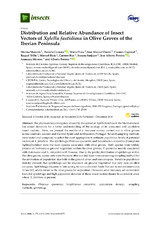Mostrar el registro sencillo del ítem
Distribution and Relative Abundance of Insect Vectors of Xylella fastidiosa in Olive Groves of the Iberian Peninsula
| dc.contributor.author | Morente, Marina | |
| dc.contributor.author | Cornara, Daniele | |
| dc.contributor.author | Plaza, María | |
| dc.contributor.author | Durán, José Manuel | |
| dc.contributor.author | Capiscol, Carmen | |
| dc.contributor.author | Trillo, Raquel | |
| dc.contributor.author | Ruiz, Manuel | |
| dc.contributor.author | Ruz, Carmen | |
| dc.contributor.author | Sanjuan, Susana | |
| dc.contributor.author | Pereira, Jose Alberto | |
| dc.contributor.author | Moreno, Aránzazu | |
| dc.contributor.author | Fereres, Alberto | |
| dc.date.accessioned | 2020-06-22T12:01:44Z | |
| dc.date.available | 2020-06-22T12:01:44Z | |
| dc.date.issued | 2018 | |
| dc.identifier.uri | http://hdl.handle.net/10396/20192 | |
| dc.description.abstract | The phytosanitary emergency caused by the spread of Xylella fastidiosa in the Mediterranean has raised demands for a better understanding of the ecology of its presumed and candidate insect vectors. Here, we present the results of a two-year survey carried out in olive groves across southern, eastern and Central Spain and northeastern Portugal. Several sampling methods were tested and compared to select the most appropriate to estimate population levels of potential vectors of X. fastidiosa. The spittlebugs Philaenus spumarius and Neophilaenus campestris (Hemiptera: Aphrophoridae) were the main species associated with olive groves. Both species were widely present on herbaceous ground vegetation within the olive groves; P. spumarius mainly associated with Asteraceae and N. campestris with Poaceae. Due to the patchy distribution of spittlebugs within the olive groves, sweep nets were the most effective and least time-consuming sampling method for the estimation of population size both in the ground cover and tree canopies. Trends in population density showed that spittlebugs can be abundant on ground vegetation but very rare on olive canopies. Spittlebugs disperse in late spring to non-cultivated hosts that act as natural reservoirs. In late fall, adults return to the olive groves for oviposition. However, olive trees may act as transient hosts for spittlebugs and high population densities of these insect vectors should be avoided in areas where X. fastidiosa is present. | es_ES |
| dc.format.mimetype | application/pdf | es_ES |
| dc.language.iso | eng | es_ES |
| dc.publisher | MDPI | es_ES |
| dc.rights | https://creativecommons.org/licenses/by/4.0/ | es_ES |
| dc.source | Insects 9(4), 175 (2018) | es_ES |
| dc.subject | Philaenus spumarius | es_ES |
| dc.subject | Neophilaenus campestris | es_ES |
| dc.subject | Population density | es_ES |
| dc.subject | Sampling methods | es_ES |
| dc.subject | Spittlebugs | es_ES |
| dc.title | Distribution and Relative Abundance of Insect Vectors of Xylella fastidiosa in Olive Groves of the Iberian Peninsula | es_ES |
| dc.type | info:eu-repo/semantics/article | es_ES |
| dc.relation.publisherversion | http://dx.doi.org/10.3390/insects9040175 | es_ES |
| dc.relation.projectID | info:eu-repo/grantAgreement/EC/H2020/635646 (POnTE) | es_ES |
| dc.relation.projectID | info:eu-repo/grantAgreement/EC/H2020/727987 (XF-ACTORS) | es_ES |
| dc.rights.accessRights | info:eu-repo/semantics/openAccess | es_ES |

